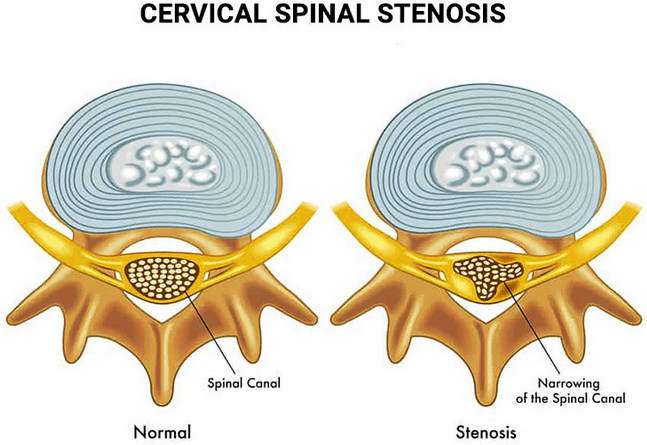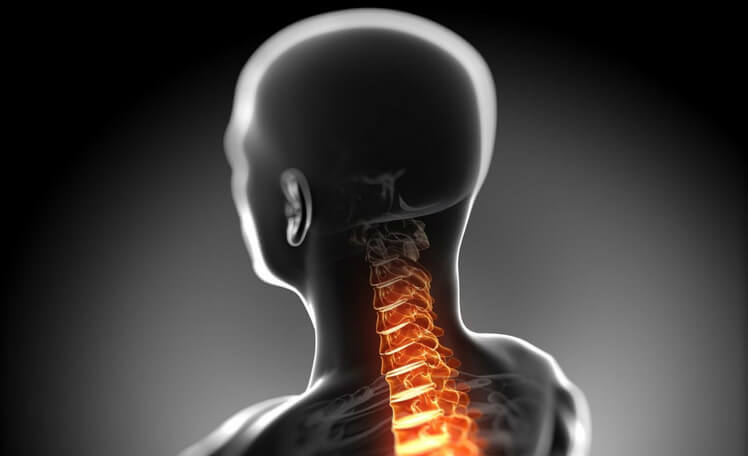What is Cervical Stenosis / Cervical Compressive Myelopathy?
Cervical spinal stenosis is a comprehensive term encompassing a variety of symptoms resulting from the narrowing of the spinal canal in the neck, which can occur due to factors like aging, injury, or degeneration.
The spinal canal, a lengthy tunnel located in the center of the spine, is positioned directly behind the bony vertebral blocks that make up the spine. Within this canal, the spinal cord and nerve roots are housed. When the spinal canal narrows, it can exert pressure on both the spinal cord and nerve roots, a condition known as cervical canal stenosis.
Cervical Stenosis:
Cervical Myelopathy, a prevalent neurologic disorder, arises from the compression of the cervical spinal cord, primarily attributed to degenerative cervical spondylosis. Typically encountered in elderly individuals, its hallmark symptoms include symmetrical numbness and tingling in the extremities, accompanied by hand clumsiness and gait instability. Given its tendency for step-wise advancement, the preferred course of action involves surgical decompression and stabilization to alleviate pressure on the spinal cord and halt further deterioration.

The spinal nerves, or "nerve roots," exit the cervical spinal canal by passing through small openings called intervertebral foraminae. These nerves then extend to the arms, controlling sensation and movement. If the intervertebral foraminae become narrowed, they can compress the nerve roots, resulting in cervical foraminal stenosis.
In essence, both cervical canal and foraminal stenosis share common underlying causes and often present with similar symptoms. These conditions frequently co-occur and are collectively referred to as cervical spinal stenosis.
Symptoms
Symptoms associated with cervical stenosis are a direct result of the abnormal compression of the spinal cord and nerve roots. Patients with this condition often experience a range of painful and uncomfortable sensations. These symptoms can include:
- Neck Pain: Discomfort or pain in the neck region.
- Arm Pain: Pain that can radiate into one or both arms.
- Electric-Like Sensations: A shooting, electrical sensation that occurs down the back when moving the head.
- Numbness in the Arms: A loss of sensation in the arms, sometimes feeling like they are "asleep."
- Arm and Hand Weakness: Weakening of the arms and hands, sometimes accompanied by a loss of coordination.
- Advanced Symptoms: In advanced stages of cervical stenosis, symptoms can escalate to include issues with bowel and bladder function. Additionally, there may be weakness and numbness in the legs and feet, which can lead to difficulties with walking.
It's essential to understand that cervical stenosis doesn't always worsen and lead to progressive symptoms. Many individuals have mild stenosis that remains asymptomatic or causes only mild, manageable symptoms that don't require treatment.

Even if symptoms become severe enough to warrant treatment, a combination of medication and physical therapy is often effective in controlling them. Your healthcare team will work closely with you to design a treatment plan tailored to your specific needs.
Causes
Cervical spinal stenosis can develop gradually due to the natural aging process and the effects of "wear and tear" on the spine. It may also be influenced by genetic factors or result from an intervertebral disc prolapse.
Here's how these processes typically unfold:
Aging and Disc Changes: As an individual ages, or due to excessive wear and tear, several processes occur:
- The intervertebral disc loses a significant portion of its water content, a condition known as "degeneration" or "desiccation." This causes the discs to decrease in height and bulge backward toward the spinal canal and intervertebral foramen.
- The facet joints, which are small spinal joints responsible for connecting vertebral bodies, tend to thicken and harden. This further narrows the spinal canal and intervertebral foramen.
- Bone spurs, known as osteophytes, often form, leading to the compression of nerves or the spinal cord.
- Spondylolisthesis, the forward slippage of one vertebra over another, can also occur, resulting in compression of spinal structures.
The cumulative effect of these structural changes is the compression of the spine, leading to the symptoms associated with cervical spinal stenosis.
Diagnosis
To pinpoint the cause of your symptoms, spine surgeon may necessitate various radiological investigations. Commonly, these investigations x-ray, encompass computed tomography (CT) and magnetic resonance imaging (MRI).

In certain circumstances, such as when an MRI is not feasible, a CT myelogram might be conducted. This procedure involves a CT scan after contrast dye is injected into the spinal canal to enhance imaging.
Occasionally, shoulder issues can mimic symptoms caused by pressure on the nerve roots. In such cases, a shoulder ultrasound and/or MRI might be ordered, or the expertise of an orthopedic specialist may be sought to evaluate and differentiate the source of the pain.
Treatment
Cervical spinal stenosis is typically managed conservatively in the initial stages. Various treatment options are available, depending on the severity of the condition and the individual's specific needs. These treatments can include:
Medication:
- Non-steroidal anti-inflammatory drugs (NSAIDs) such as aspirin, ibuprofen, and naproxen are used to alleviate pain and reduce inflammation.
- Corticosteroids (e.g., prednisolone) may be prescribed for a short duration.
- Medications designed to address nerve pain, such as pregabalin, can also be considered.
Physical Therapies:
- Non-surgical approaches like physiotherapy,
- Physical therapy modalities like heat or ice packs, ultrasound, electrical stimulation, and massage can help relax tight muscles and alleviate discomfort.
Epidural Steroid Injection:
In severe cases, a local anesthetic may be injected around the compressed nerve. This can serve both diagnostic and therapeutic purposes.
Surgery:
Severe or unresponsive cases of cervical spinal stenosis may require surgical intervention. Various surgical procedures can be performed to alleviate pressure on the spinal cord and nerves while enhancing spinal stability. These procedures include:
- Anterior cervical decompression and fusion
- Cervical arthroplasty (artificial disc insertion)
- Cervical laminectomy
- Keyhole foraminotomy
- Posterior cervical decompression and fusion
The choice of treatment depends on the patient's specific condition and the recommendations of a healthcare professional.



